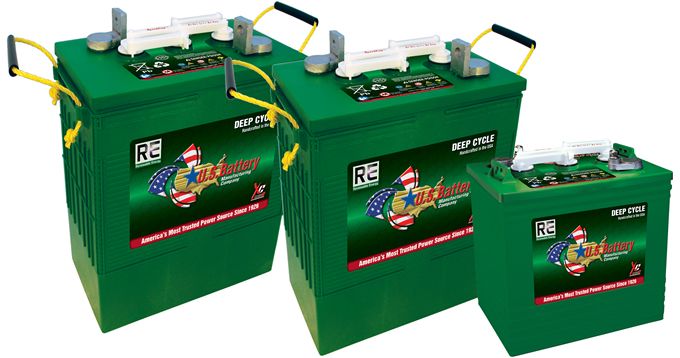It is much more efficient to add energy storage closer to the point of use; such as with homeowners, subdivisions, communities, small towns and cities.
 Deep-Cycle Batteries used for Energy Storage
Deep-Cycle Batteries used for Energy Storage

Fred Wehmeyer, Senior VP Engineering | U.S. Battery
Tell us a little bit about U.S. Battery and what sets your batteries apart from others?
U.S. Battery’s advantages in the deep-cycle battery world are longest cycle-life, higher initial capacity, and faster cycle up to full rated capacity.
What trends are you currently seeing in Energy storage?
The U.S. power grid is becoming more unreliable every year. Energy storage can provide an increased level of reliability with backup power during energy blackouts and brownouts. Also, the feasibility of solar based power generation is increased by storing energy when solar is available for use, even at night or on heavy overcast days.
National and city-wide energy storage solutions seem decades away, so is there something individual homeowners can do?
Not only is national energy storage years away but it is not the most efficient method of storing and using energy due to power transmission losses. Therefore, it is much more efficient to add energy storage closer to the point of use; such as with homeowners, subdivisions, communities, small towns and cities.
When it comes to deep-cycle batteries used for energy storage, what are the differences in using an AGM versus an FLA battery?
AGM batteries have the advantage of not requiring regular maintenance but are more costly and may not last as long as well-maintained flooded deep-cycle batteries. They are also more susceptible to abuse such as overcharging and undercharging.
.jpg)
How can homeowners and installers properly size their battery bank for their individual purposes?
U.S. Battery has a battery sizing calculator on our website (https://usbattery.com/calculator/energy-chart.html) that helps estimate the total loads and runtimes for sizing the battery and the recharge requirements.
After installing a battery bank for home or business energy storage, what are the routine maintenance procedures that need to be addressed?
Flooded deep-cycle batteries should be regularly charged to full capacity, (at least weekly in heavy use applications). Water levels should be checked monthly and watered added as needed. Terminals should be cleaned and tightened monthly. Care and Maintenance Procedures are outlined on our website at (https://www.usbattery.com/info-center/care-and-maintenance/)
What is required to properly charge deep-cycle batteries?
U.S. Battery provides charging recommendations for both flooded deep-cycle and sealed AGM deep-cycle batteries on our website. ( https://www.usbattery.com/technical-info/charging-instructions/) Customers should always consult these recommendations when purchasing and installing chargers or charge controllers.
Give us the case for lead-acid batteries over lithium-ion for home energy storage?
Lead-acid batteries are much lower in cost per watt-hour and are much safer to use than lithium ion batteries. Even though lithium batteries have higher energy density, which is important for vehicular applications, home energy storage does not require high energy density since they are used in a stationary application. Lead-acid batteries are also much more resistant to abuse and can survive in a wider range of temperatures without expensive battery management systems (BMS’s).
 Fred Wehmeyer is Senior Vice President of Engineering for U. S. Battery Manufacturing Company, Inc. in Augusta, Georgia. Fred is a seasoned battery professional with more than 40 years experience in the design, manufacture, and quality assurance/testing of rechargeable batteries including lead-acid, nickel-cadmium, nickel-metal hydride, and lithium based chemistries. Fred’s previous experience was as Vice President of Quality Assurance for EnerSys and Director of Product and Process Engineering for C&D Technologies. Fred has a Bachelor of Science Degree in Electrochemistry and has done graduate work in Engineering Management and Six Sigma/Lean Engineering.
Fred Wehmeyer is Senior Vice President of Engineering for U. S. Battery Manufacturing Company, Inc. in Augusta, Georgia. Fred is a seasoned battery professional with more than 40 years experience in the design, manufacture, and quality assurance/testing of rechargeable batteries including lead-acid, nickel-cadmium, nickel-metal hydride, and lithium based chemistries. Fred’s previous experience was as Vice President of Quality Assurance for EnerSys and Director of Product and Process Engineering for C&D Technologies. Fred has a Bachelor of Science Degree in Electrochemistry and has done graduate work in Engineering Management and Six Sigma/Lean Engineering.
The content & opinions in this article are the author’s and do not necessarily represent the views of AltEnergyMag

US Battery
Since 1926, we have been designing and manufacturing the highest quality deep cycle batteries in the world. Starting out as a small manufacturing operation in San Diego, California and growing to the global company that you see today, having locations in Corona, California, Evans, Georgia and Augusta, Georgia, we work each day to supply our customers with the best batteries available. Through innovation and technology our products are the go-to energy storage batteries for a variety of applications including: scissor lifts, sweeper/scrubbers, golf carts, boats, RVs, renewable energy, and many other industries that require the constant energy delivered by quality deep-cycle batteries.
Other Articles
Lithium Batteries for Renewable Energy Applications
The Truth About Reviving Dead Batteries
Battery Recycling Can Lead to a Better Future for Energy Resources
More about US Battery
Comments (1)
Featured Product

